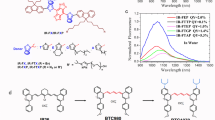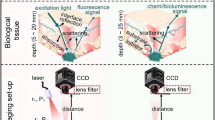Abstract
Fluorescence imaging has been widely employed for biomedical research and clinical diagnostics. With ease of synthesis and excellent photophysical properties, D–A type fluorophores are widely designed for fluorescence imaging. However, traditional D–A type fluorophores are solvatochromic which reduces the fluorescence brightness in the biological system. To solve this problem and build on our previous work, we devised a novel HIEE fluorophore MTC with typical anti-solvatochromic fluorescence. Furthermore, the activated fluorescent probe designed based on MTC showed excellent imaging performance. We believe that the strategy based on the fluorophores with typical anti-solvatohromic fluorescence can be a useful platform for designing fluorescent probes for high-brightness imaging in the biological system.
Graphical Abstract









Similar content being viewed by others
References
Xu W, Zeng ZB, Jiang JH, Chang YT, Yuan L. Discerning the chemistry in individual organelles with small-molecule fluorescent probes. Angew Chem Int Ed. 2016;55:13658–99.
Chen XQ, Wang F, Hyun JY, Wei TW, Qiang J, Ren XT, et al. Recent progress in the development of fluorescent, luminescent and colorimetric probes for detection of reactive oxygen and nitrogen species. Chem Soc Rev. 2016;45:2976–3016.
Huang JG, Li JC, Lyu Y, Miao QQ, Pu K. Molecular optical imaging probes for early diagnosis of drug-induced acute kidney injury. Nat Mater. 2019;18:1133–43.
Zhang Y, Zhang XQ, Yang HC, Yu L, Xu Y, Sharma A, et al. Advanced biotechnology-assisted precise sonodynamic therapy. Chem Soc Rev. 2021;50:11227–48.
Alamudi SH, Satapathy R, Kim J, Su DD, Ren HY, Das R, et al. Development of background-free tame fluorescent probes for intracellular live cell imaging. Nat Commun. 2016;7:1–9.
Liu HW, Chen LL, Xu CY, Li Z, Zhang HY, Zhang XB, et al. Recent progresses in small-molecule enzymatic fluorescent probes for cancer imaging. Chem Soc Rev. 2018;47:7140–80.
Li XH, Gao XH, Shi W, Ma HM. Design strategies for water-soluble small molecular chromogenic and fluorogenic probes. Chem Rev. 2014;114:590–659.
Kowada T, Maeda H, Kikuchi K. BODIPY-based probes for the fluorescence imaging of biomolecules in living cells. Chem Soc Rev. 2015;44:4953–72.
Yuan L, Lin WY, Zheng KB, He LW, Huang WM. Far-red to near infrared analyte-responsive fluorescent probes based on organic fluorophore platforms for fluorescence imaging. Chem Soc Rev. 2013;42:622–61.
Yang ZG, Sharma A, Qi J, Peng X, Lee DY, Hu R, et al. Super-resolution fluorescent materials: an insight into design and bioimaging applications. Chem Soc Rev. 2016;45:4651–67.
Zheng QS, Juette MF, Jockusch S, Wasserman MR, Zhou Z, Altman RB, et al. Ultra-stable organic fluorophores for single-molecule research. Chem Soc Rev. 2014;43:1044–56.
Zhang XX, Ren TB, Yang FY, Yuan L. Rational design of far red to near-infrared rhodamine analogues with huge Stokes shifts for single-laser excitation multicolor imaging. Chin Chem Lett. 2021;32:3890–4.
Wang Z, Zhang F, Xiong JH, Mao ZQ, Liu ZH. Investigations of drug-induced liver injury by a peroxynitrite activatable two-photon fluorescence probe. Spectrochim Acta A Mol Biomol Spectrosc. 2021;246:118960.
Wang WW, Xiong JH, Song XJ, Wang Z, Zhang F, Mao ZQ. Activatable two-photon near-infrared fluorescent probe tailored toward peroxynitrite in vivo imaging in tumors. Anal Chem. 2020;92:13305–12.
Chen H, Shang HM, Liu Y, Guo R, Lin WY. Development of a unique class of spiro-type two-photon functional fluorescent dyes and their applications for sensing and bioimaging. Adv Funct Mater. 2016;26:8128–36.
Cai FY, Hou B, Zhang SP, Chen H, Ji SC, Shen XC, et al. A chromenoquinoline-based two-photon fluorescent probe for the highly specific and fast visualization of sulfur dioxide derivatives in living cells and zebrafish. J Mater Chem B. 2019;7:2493–8.
Chen H, Tang YH, Shang HM, Kong XQ, Guo R, Lin WY. Development of a unique family of two-photon full-color-tunable fluorescent materials for imaging in live subcellular organelles, cells, and tissues. J Mater Chem B. 2017;5:2436–44.
Xu Y, Li C, Ma X, Tuo W, Tu L, Li X, Sun Y, Stang PJ, Sun Y. Long wavelength-emissive Ru(II) metallacycle-based photosensitizer assisting in vivo bacterial diagnosis and antibacterial treatment. PNAS. 2022;119:e2209904119.
Liu XG, Qiao QL, Tian WM, Liu WJ, Chen J, Lang MJ, et al. Aziridinyl fluorophores demonstrate bright fluorescence and superior photostability by effectively inhibiting twisted intramolecular charge transfer. J Am Chem Soc. 2016;138:6960–3.
Lavis LD, Raines RT. Bright ideas for chemical biology. ACS Chem Bio. 2008;3:142–55.
Specht EA, Braselmann E, Palmer AE. A critical and comparative review of fluorescent tools for live-cell imaging. Annu Rev Physiol. 2017;79:93–117.
Hoelzel CA, Hu H, Wolstenholme CH, Karim BA, Munson KT, Jung KH, et al. A general strategy to enhance donor-acceptor molecules using solvent-excluding substituents. Angew Chem Int Ed. 2020;59:4785–92.
Ren TB, Xu W, Zhang QL, Zhang XX, Wen SY, Yi HB, et al. Enhancing the anti-solvatochromic two-photon fluorescence for cirrhosis imaging by forming a hydrogen-bond network. Angew Chem Int Ed. 2018;57:7473–7.
Zheng YX, Zhang XX, Shi L, Ren TB, Yuan L, Zhang XB. Reversal of solvatochromism: a new strategy to construct activatable two-photon fluorescent probes for sensing. Chem Asian J. 2022;17:e202101197.
Zhang XX, Ren TB, Zhang QL, Zeng T, Li Z, Yang FY, et al. Molecular design strategy to alleviate environmental interference on two-photon fluorescence probes. Cell Rep Phys Sci. 2021;2:100471.
Qiu KQ, Chen Y, Rees TW, Ji LN, Chao H. Organelle-targeting metal complexes: from molecular design to bio-applications. Coord Chem Rev. 2019;378:66–86.
Li MY, Li K, Liu YH, Zhang H, Yu KK, Liu X, et al. Mitochondria-immobilized fluorescent probe for the detection of hypochlorite in living cells, tissues, and zebrafishes. Anal Chem. 2020;92:3262–9.
Yuan L, Wang L, Agrawalla BK, Park SJ, Zhu H, Sivaraman B, et al. Development of targetable two-photon fluorescent probes to image hypochlorous acid in mitochondria and lysosome in live cell and inflamed mouse model. J Am Chem Soc. 2015;137:5930–8.
Beija M, Afonso C, Martinho J. Synthesis and applications of Rhodamine derivatives as fluorescent probes. Chem Soc Rev. 2009;38:2410–33.
Costa SPG, Batista RMF, Cardoso P, Belsley M, Raposo MMM. 2-Arylthienyl-substituted 1,3-benzothiazoles as new nonlinear optical chromophores. Eur J Org Chem. 2006;17:3938–46.
Rao AS, Kim D, Wang T, et al. Reaction-based two-photon probes for mercury ions: fluorescence imaging with dual optical windows. Org Lett. 2012;14:2598–3260.
Kim D, et al. Recent development of two-photon fluorescent probes for bioimaging. Org Biomol Chem. 2014;12:4550–66.
Chatzicharalampous C, Yahfoufi Z, Morris RT, Awonuga A, Abu-Soud HM. The role of myeloperoxidase and hypochlorous acid in oocyte quality: a friend or foe? Reprod Sci. 2019;26:286.
Winterbourn CC, Hampton MB, Livesey JH, Kettle AJ. Modeling the reactions of superoxide and myeloperoxidase in the neutrophil phagosome — implications for microbial killing. J Biol Chem. 2006;281:39860–9.
Witko-Sarsat W, Gausson V, Nguyen AT, Touam M, Drueke T, Santangelo F, et al. AOPP-induced activation of human neutrophil and monocyte oxidative metabolism: a potential target for N-acetylcysteine treatment in dialysis patients. Kidney Int. 2003;64:82–91.
Wu WL, Zhao X, Xi LL, Huang MF, Zeng WH, Miao JY, et al. A mitochondria-targeted fluorescence probe for ratiometric detection of endogenous hypochlorite in the living cells. Anal Chim Acta. 2017;950:178–83.
Yan YH, Ma HL, Miao JY, Zhao BX, Lin ZM. A ratiometric fluorescence probe based on a novel recognition mechanism for monitoring endogenous hypochlorite in living cells. Anal Chim Acta. 2019;1064:87–93.
Ji DD, Li G, Zhang SM, Zhu MY, Li C, Qiao RZ. Mitochondria-targeted fluorescence probe for endogenous hypochlorite imaging in living cells and zebra fish. Sens Actuator B-Chem. 2018;259:816–24.
Weitzman SA, Gordon LI. Inflammation and cancer: role of phagocyte-generated oxidants in carcinogenesis. Blood. 1990;76:655–63.
Al-Salihi M, Reichert E, Fitzpatrick FA. Influence of myeloperoxidase on colon tumor occurrence in inflamed versus non-inflamed colons of Apc(Min/+) mice. Redox Biol. 2015;6:218–25.
Funding
This work is supported by NSFC (22004033, 21977027, 21877029, 21605091) and Shandong Key Laboratory of Biochemical Analysis (SKLBA2107).
Author information
Authors and Affiliations
Corresponding authors
Ethics declarations
Ethics approval
All animal experiments were performed in accordance with protocol no. SYXK (Xiang) 2008–0001 approved by the Laboratory Animal Center of Hunan.
Conflict of interest
The authors declare no competing interests.
Additional information
Publisher's note
Springer Nature remains neutral with regard to jurisdictional claims in published maps and institutional affiliations.
Published in the topical collection Young Investigators in (Bio-)Analytical Chemistry 2023 with guest editors Zhi-Yuan Gu, Beatriz Jurado-Sánchez, Thomas H. Linz, Leandro Wang Hantao, Nongnoot Wongkaew, and Peng Wu.
Supplementary Information
Below is the link to the electronic supplementary material.
Rights and permissions
Springer Nature or its licensor (e.g. a society or other partner) holds exclusive rights to this article under a publishing agreement with the author(s) or other rightsholder(s); author self-archiving of the accepted manuscript version of this article is solely governed by the terms of such publishing agreement and applicable law.
About this article
Cite this article
Wang, SM., Lou, X., Xu, S. et al. Engineering of a novel D–A type fluorophore with hydrogen bond-induced enhanced emission property for sensitively detecting endogenous HOCl in living cells and tissues. Anal Bioanal Chem 415, 4185–4196 (2023). https://doi.org/10.1007/s00216-023-04550-9
Received:
Revised:
Accepted:
Published:
Issue Date:
DOI: https://doi.org/10.1007/s00216-023-04550-9




